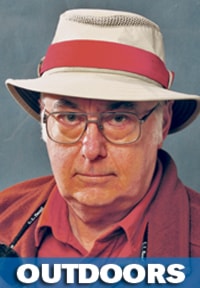On Sept. 19, a class-action law suit against the government of Newfoundland and Labrador on behalf of people injured in moose-vehicle collisions was dismissed by Justice Robert Stack of the Supreme Court of Newfoundland and Labrador.
Almost a month later, the Alberta and federal governments announced that there will absolutely be no massive roundup or cull of the burgeoning Canadian Forces Base Suffield elk herd that is causing serious problems in the area, including collisions with vehicles.
There are other cross-country similarities and lessons to be learned here, which we’ll get to later.
The number of moose-vehicle collisions in Newfoundland and Labrador has doubled in the past decade to 800 per year, according to police records. Even back 40 years ago, the late Tom O’Keefe and I almost got mooshed twice on our 800-km drive from St. John’s to Port aux Basques.
In dismissing the suit, Stack found “there was no evidence to prove the moose population management or moose-vehicle collision risk mitigation were irrational or done in bad faith, and, as a result, government is immune from a negligence lawsuit.”
Newfoundland and Labrador has the most concentrated moose population in North America, with a herd now estimated at 115,000, down from 150,000 in 1997.
To put the density in perspective: with less than two-thirds Alberta’s area, Newfoundland and Labrador fundamentally has as many as Alberta’s estimated 118,000 moose.
All moose in Newfoundland and Labrador are descended from only four head transplanted from New Brunswick in 1904, probably before there were any automobiles in the province, or roads fit for them. There was no claim for “nuisance” (later) in the class-action suit, probably because it is 110 years since the four moose were introduced, with the full hope that they would go forth and multiply.
It was only back in 1997-98 when the feds, and the military at Canadian Forces Base Suffield in southeastern Alberta, introduced, or ”re-introduced,” as some like to claim, 220 surplus elk from Elk Island National Park onto the base, apparently to replace the feral horses they felt were too harmful to the ecosystem.
In little more than 15 years, on prime prairie grassland, with virtually no predators, those 220 elk have become an estimated 6,000 to 8,000 head that are increasing by 20 per cent annually, and are now escaping the base to the surrounding country and causing major damage to the fences, grass, crops and bale yards of area farmers and ranchers.
Recent very limited hunting seasons, mainly for cow elk, have not alleviated the problem, yet the feds and the province continue to put their faith in hunters to control the huge herd, rejecting any other solutions suggested by area residents. This year, the number of cow elk tags for the area has been doubled to 600.
But elk are wily critters and Alberta hunter success rates with them rarely exceeds 25 per cent, so, if we’re lucky, 150 of those CFB Suffield cow elk will die, not much of a dent in the 1,200 to 1,600 annual increase in the herd. Surely whatever wildlife managers are left in Alberta have to know this and aren’t serious about dealing with an increasingly disastrous problem for the residents of the area, or they just aren’t paying attention.
Something must be done quickly to grab the full attention of the federal and provincial governments. If I were a farmer or rancher in the area, I’d be retaining the best counsel available — preferably a class action lawyer who also knows wildlife mismanagement when he sees it — to commence a class-action lawsuit on behalf of all people damaged by the CFB Suffield elk herd.
Unlike in Newfoundland and Labrador, the principal cause of action would be for nuisance, the new “tort” (civil wrong) first enunciated by the House of Lords in 1868 in Rylands and Fletcher.
Basically, the case decided that anyone who allows a dangerous element on their land, which, if it escapes and damages a neighbour, is liable on a strict liability basis; it is not necessary to prove negligence on the landowner from which the dangerous element has escaped. It would be interesting to see to what extent Alberta aided and abetted the creation of the nuisance.
But there is also ample negligence to go around here, including that the feds were warned in advance of just what is happening now unless they had a management plan in place and, more than 15 years later, neither they nor the province have the slightest idea what to do about the monster they have created.
The feds stonewall farmers and ranchers wanting to talk about solutions, and they and the province reject plans for massive roundups and culls that could effectively reduce the current size and growth of the nuisance, the disaster.
If they won’t even talk, it’s time for action: a class action.
Bob Scammell is an award-winning columnist who lives in Red Deer. He can be reached at bscam@telusplanet.net.
